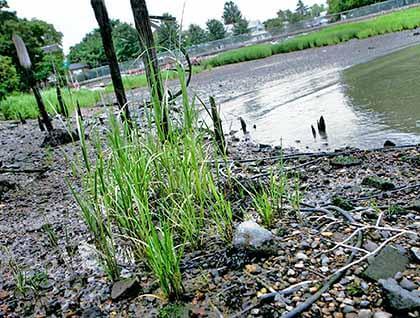By Rebecca Henely
While the new cap on the Deepwater Oil Rig in the Gulf of Mexico has as of this week temporarily stopped the months-long oil spill in the Gulf of Mexico, environmental scientist Dr. James Cervino said that based on his observations in College Point the Gulf may not be cleaned up for 100 years.
For the last six years, Cervino has been working and doing experiments to restore the marsh grasses in the East River along MacNeil Park. After seeing fellow scientist Michael Blum of Tulane University in New Orleans speak about his research on the effects of the BP oil spill on “The Rachel Maddow Show,” Cervino asked Blum to send him crude oil from the Gulf to test on samples of spartina marsh grass growing in the East River along the park.
“These are the types of marsh grasses that are being killed by the BP oil spill,” Cervino said.
Early tests of crude oil on the grasses — all done in a laboratory, not on-site —were not good.
“I expose it. It dies,” Cervino said, adding that cell death happens within 24 hours.
Yet Cervino’s work at home hints at a potential happy ending for environments suffering due to oil spills.
With a $5,000 grant from City Councilman Dan Halloran (R-Whitestone), and a new laboratory at the LandServ Environmental Group in Astoria he moved into last month, Cervino is gearing up to do a series of experiments with the crude. The experiments started in the Florida Keys about three weeks after the BP spill, where Cervino tested the oil crude on coral samples and found they died within 24 hours under undiluted crude.
When he gets his next batch of oil from Blum, Cervino plans to test it on not only samples of the local marsh grass, but also local shellfish, as well as on coral samples and coral cell lines from areas around the globe. The samples will be tested in a laboratory setting and with both undiluted crude oil and diluted crude oil from the Gulf.
“We’ll be able to know the toleration limits,” Cervino said of the samples he is testing. “How much can they take and how long will it take to recover?”
This question is crucial for Cervino’s work in the Gulf and at home. Cervino said that on the site of the nearby Soundview Point Townhouses there was once an illegal landfill from the 1950s to the 1980s. Oil drums were buried within this landfill and oil from the drums leached into the nearby East River. This prevented marsh grasses from growing and killed much of the local wildlife.
But the developer of Soundview cleaned up the site well before building the townhouses, Cervino said, and he is working to bring the wildlife back. Through his experiments, Cervino has found that on sites exposed to oil, no roots can plant about 7 centimeters below the surface. But by electrically stimulating the soil, calcium carbonate and marsh grass can grow where the land was once unable to support life. Cervino has been able to do that through the use of a wire mesh electrically charged via solar panel and has already seen results.
“Whitestone and College Point, we’re getting help,” Cervino said.
Cervino said he has been regrowing grasses for six years so far. The project will last 10 years and he hopes to get funding for another 10 after that. With his current grant, Cervino also hopes to use it as a starting point to raise $20,000 and create an environmental science community garden at PS 129.
Cervino said he hoped the new cap on the rig works, but hopes this will mark a shift from deepwater drilling to more alternative energy sources, such as solar.
He also hopes restoration can be done in the Gulf.
“Restoration can work,” he said. “There’s a positive end to this story.”
Reach reporter Rebecca Henely by e-mail at rhenely@cnglocal.com or by phone at 718-260-4564.


































